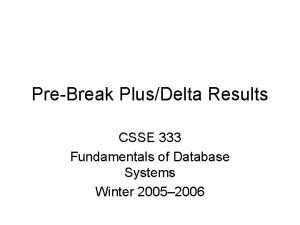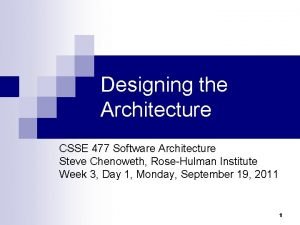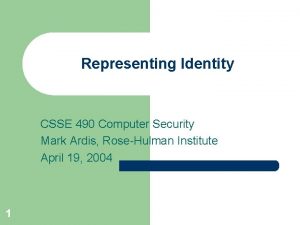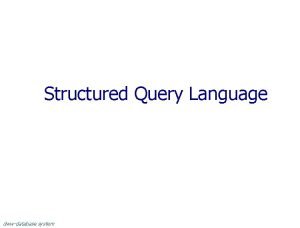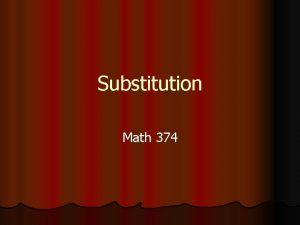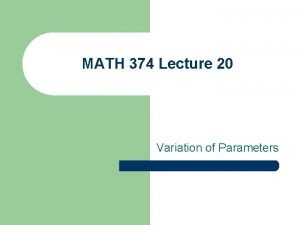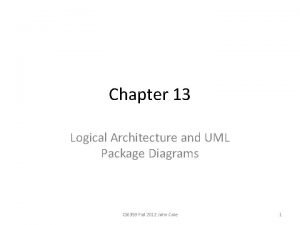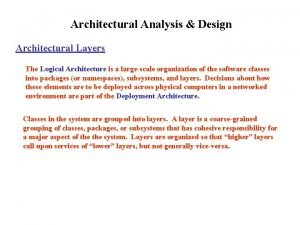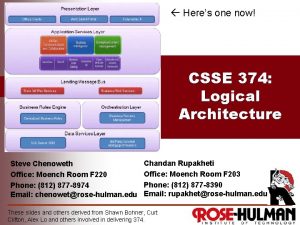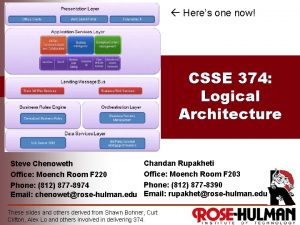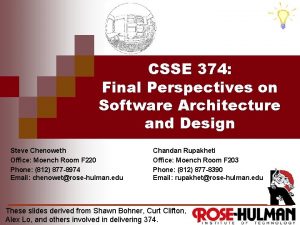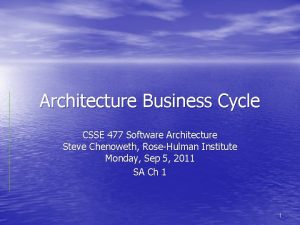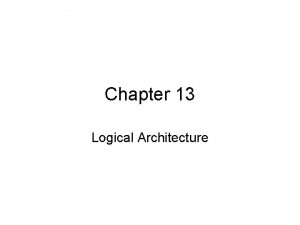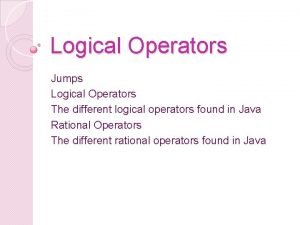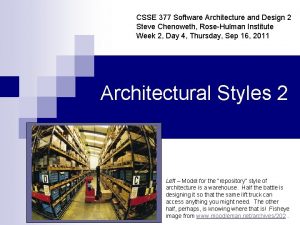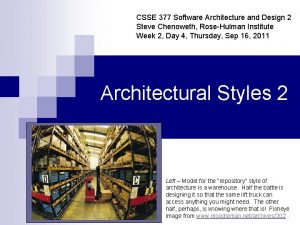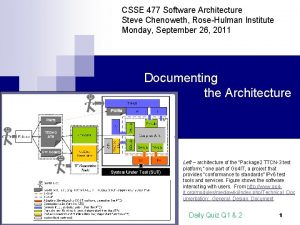Heres one now CSSE 374 Logical Architecture Steve


























- Slides: 26

Here’s one now! CSSE 374: Logical Architecture Steve Chenoweth Office: Moench Room F 220 Phone: (812) 877 -8974 Email: chenowet@rose-hulman. edu Chandan Rupakheti Office: Moench Room F 203 Phone: (812) 877 -8390 Email: rupakhet@rose-hulman. edu These slides and others derived from Shawn Bohner, Curt Clifton, Alex Lo and others involved in delivering 374.

Logical Architecture is An Engineering Decision… So, what’s logical?

Learning Outcomes: O-O Design Demonstrate object-oriented design basics like domain models, class diagrams, and interaction (sequence and communication) diagrams. http: //enterprisegeeks. com/blog/2009/07/ n n n Describe Software Architecture Explain why architecture is important Get into the layers…

From Requirements to Architecture Customer Requirements "four bedrooms, three baths, lots of glass. . . " Architectural Design n n How do we get from here …to there? Think for 15. 26667 seconds… Turn to a neighbor and discuss it for a minute

Software Architecture Definitions n The large-scale motivations, constraints, organization, patterns, responsibilities, and connections [between components] of the system. Craig Larman 2003 n The structure or structures of the system, which comprise software components, the externally visible properties of those components, and the relationships among them. Bass, et al, 1998

Architectural Building Blocks Component – a unit of computation or a data store Connector – an architectural element that models interactions among components and rules that govern those interactions Configuration (or topology) – a connected graph (composite) of components and connectors which describe architectural structure Q 1

Why Software Architecture? Enables the software engineer to: 1. Analyze the effectiveness of the design in meeting its stated requirements 2. Consider architectural alternatives at a stage when making design changes is still relatively easy 3. Reduce the risks associated with the construction of the software 4. Provide key Abstractions in reasoning about design 5. Establish a Design Plan

UML Architectural Views n Logical Architecture – describes the system in terms of its organization in layers, packages, classes, interfaces and subsystems ¨ n To be followed shortly by an “action view” of this… Deployment Architecture – describes the system in terms of the allocation of processes to processing units and network configurations Beautiful, huh. What it is. What it does. How it looks.

UML Package Diagrams n n Describes grouping of elements Can group anything: Package Names ¨ Classes ¨ Other n packages More general than Java packages or C# namespaces Dependency Line Fully qualified name is: Domain: : Sales Q 2

Alternative Nesting Notations Traditional Nested Notation Fully-Qualified Notation Cross-Circle Notation Q 3

Designing with Layers Solves Problems n n Rippling source code changes Intertwining of application and UI logic Intertwining of application logic and technical services Difficult division of labor Consider a case history… Q 4

Designing with Layers Solves Problems – A Case History n n n Day 1 – On your summer internship coming up, Your boss says, “Give me a little system I can use on my laptop to drill down on the data on this memory stick. ” You write it in Java, with a Swing GUI, to run on his laptop. Then…

Designing with Layers Solves Problems – A Case History n n Day 21 – Your boss says, “I showed this at our weekly bosses’ meeting. Everybody wants it. You say, “On their laptops, too”? He says, “Well, no, we would need to be able to share the data!” Like you should have known that. You and 3 other interns rewrite it, still in Java, with a server, on SQL-Server, with a web interface, and security added so they can use it from home. ¨ Suddenly architecture and interfaces become crucial! Then…

Designing with Layers Solves Problems – A Case History n n n Day 61 – The VP of your division shows it to the big boss at the quarterly management meeting, and she likes it! Your VP says, “They want it to do the same thing with all these other little bits of data, too. ” You watch as a full team of 14 people use your system as a starting point and rewrite it. Then… You say, I’m going back to Rose-Hulman!

Benefits of Architecture Layers n Separation of concerns ¨ Reduces coupling and dependencies; improves cohesion; increases reuse potential and clarity n Essential complexity is encapsulated n Can replace some layers with new implementations (e. g. , platform independence) n Can distribute some layers n Can divide development within/across teams

Common Layers in More Detail (1 of 2) Q 5

Common Layers in More Detail (2 of 2) Systems will have many, but not necessarily all, of these Q 5

Exercise on Logical Architecture n Break up into your project teams n Given the following packages: ¨ Rental Process GUI, Rental ¨ Provision GUI, Provision ¨ Payment GUI, Payment ¨ Membership, Security ¨ Persistence, Directory Services n Draw a BBVS Logical Architecture diagram with the UI, Domain, and Technical Services Layers

Designing the Domain Layer n n Create software objects with names and information similar to the realworld domain Assign application logic responsibilities “Domain Objects” Q 6

Terminology: Layers vs. Partitions Layers Partitions Q 7

Common Mistake: Showing External Resources Worse Better

Model-View Separation Principle n n n Eas y spo way to t an OO ama teur ! Do not connect non-UI objects directly to UI objects ¨ E. g. , A Sale object shouldn’t have a reference to a UI object (e. g. , Jframe) Do not put application logic in UI object methods ¨ A UI event handler should just delegate to the domain layer Note: Model domain layer; View UI layer MVC image from Wikipedia! Q 8

From SSDs to Layers System operations on the SSDs will become the messages sent from the UI layer to the domain layer Q 9

Common Object Design Techniques n Just code it: design while coding, heavy emphasis on refactoring and powerful IDEs n Draw, then code: sketch some UML, then code it n Just draw it: generate code from diagrams http: //www. virginmedia. com/movies/galleries/previews/indiana-jones-idols. php? ssid=7

Static vs. Dynamic Modeling n Static models ¨ Class n diagrams Interaction Diagrams Dynamic models ¨ Sequence diagrams ¨ Communication diagrams Spend time on interaction diagrams, not just class diagrams

Prefer Design Skill over UML skill n UML is only a tool for object design n The real skill is the design, …NOT the diagramming n Fundamental object design requires knowledge of: ¨ Principles of responsibility assignment ¨ Design patterns
 Heres to right now
Heres to right now Csse results
Csse results Csse quiz server
Csse quiz server Mark ardis
Mark ardis Csse exam
Csse exam Heres to you jesusa
Heres to you jesusa Sql exercise
Sql exercise Texas. heres why.
Texas. heres why. The art heres look
The art heres look Heres hank
Heres hank 800 en yakın yüzlüğe yuvarlama
800 en yakın yüzlüğe yuvarlama Cse 374
Cse 374 Nrsg 374 assignment 1
Nrsg 374 assignment 1 Ece 374
Ece 374 Ce 374
Ce 374 Llllly
Llllly Variation in mathematics
Variation in mathematics Ce 374
Ce 374 Ce 374
Ce 374 Logical equivalence examples
Logical equivalence examples Logical form and logical equivalence
Logical form and logical equivalence Steve jobs, steve wozniak, and ronald wayne
Steve jobs, steve wozniak, and ronald wayne Now i see it now you don't
Now i see it now you don't Logical architecture diagram
Logical architecture diagram Wta logical architecture
Wta logical architecture Facade design pattern
Facade design pattern Logical architecture definition
Logical architecture definition

